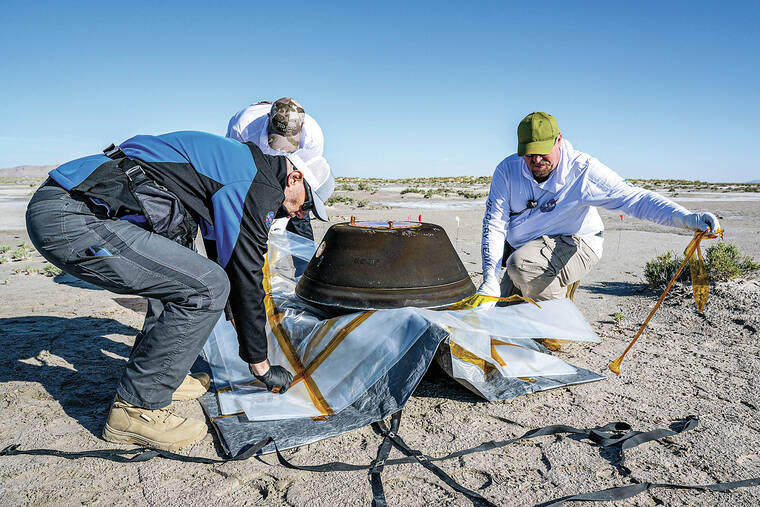NASA’s first asteroid samples land on Earth after release from spacecraft
NASA’s first asteroid samples fetched from deep space parachuted into the Utah desert Sunday to cap a seven-year journey.
In a flyby of Earth, the Osiris-Rex spacecraft released the sample capsule from 63,000 miles (100,000 kilometers) out. The small capsule landed four hours later on a remote expanse of military land, as the mothership set off after another asteroid.
ADVERTISING
“We have touchdown!” Mission Recovery Operations announced, immediately repeating the news since the landing occurred three minutes early. Officials later said the orange striped parachute opened four times higher than anticipated — around 20,000 feet (6,100 meters) — basing it on the deceleration rate.
To everyone’s relief, the capsule was intact and not breached, keeping its 4.5 billion-year-old samples free of contamination. Within two hours of touchdown, the capsule was inside a temporary clean room at the Defense Department’s Utah Test and Training Range, hoisted there by helicopter.
The sealed sample canister will be flown today to NASA’s Johnson Space Center in Houston, where it will be opened in a new, specially designed lab. The building already houses the hundreds of pounds (kilograms) of moon rocks gathered by the Apollo astronauts.
“We can’t wait to crack into it. For me, the real science is just beginning,” said the mission’s lead scientist, Dante Lauretta of the University of Arizona. He’ll accompany the samples all the way to Texas.
Lori Glaze, NASA’s planetary science division director, added: “Those are going to be a treasure for scientific analysis for years and years and years to come.”
Scientists estimate the capsule holds at least a cup of rubble from the carbon-rich asteroid known as Bennu, but won’t know for sure until the container is opened in a day or two. Some spilled and floated away when the spacecraft scooped up too much material, which jammed the container’s lid during collection three years ago.
Japan, the only other country to bring back samples, gathered about a teaspoon during a pair of asteroid missions.
The pebbles and dust delivered Sunday represent the biggest haul from beyond the moon.
Preserved building blocks from the dawn of our solar system, the samples will help scientists better understand how Earth and life formed, providing “an extraordinary glimpse” of 4.5 billion years ago, said NASA Administrator Bill Nelson.
Osiris-Rex, the mothership, rocketed away on the $1 billion mission in 2016. It reached Bennu two years later and, using a long stick vacuum, grabbed rubble from the small roundish space rock in 2020. By the time it returned, the spacecraft had logged 4 billion miles (6.2 billion kilometers).
At a news conference several hours later, Lauretta said he broke into tears of joy upon hearing that the capsule’s main parachute had opened.
“I knew we had made it home,” he said, so overwhelmed with emotion when he arrived at the scene that he wanted to hug the capsule, sooty but undamaged and not even bent.
Flight controllers for spacecraft builder Lockheed Martin stood and applauded the touchdown from their base in Colorado. NASA camera views showed the charred capsule upside down on the sand with its parachute disconnected and strewn nearby, as the recovery team moved in via helicopters.
“Boy, did we stick that landing,” Lauretta said.
British astronomer Daniel Brown, who was not involved in the mission, said he expects “great things” from NASA’s largest sample return since the Apollo moon landings more than a half-century ago. With these asteroid samples, “we are edging closer to understanding its early chemical composition, the formation of water and the molecules life is based on,” he added from Nottingham Trent University.





